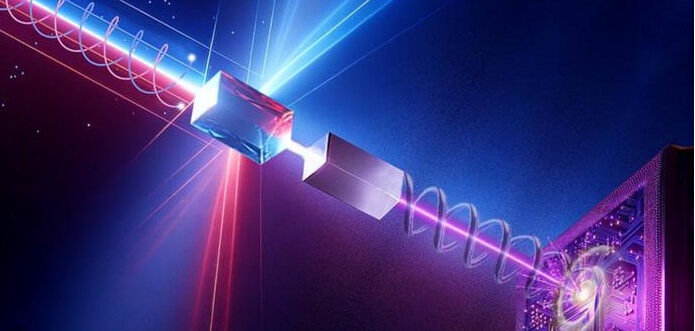
Breakthroughs in Deep Ultraviolet Laser Technology Explained

Deep ultraviolet solid-state laser with a compact setup generates a vortex at 193 nm wavelength. Image Credit: Prof. Hongwen Xuan (Chinese Academy of Sciences).
Researchers developed a compact, solid-state laser system that generates 193-nm coherent light — the first 193-nm vortex beam — promising significant advancements in semiconductor lithography and other high-tech applications
Deep ultraviolet (DUV) lasers, known for their high photon energy and short wavelengths, are essential in various fields such as semiconductor lithography, high-resolution spectroscopy, precision material processing, and quantum technology. These lasers offer increased coherence and reduced power consumption compared to excimer or gas discharge lasers, enabling the development of more compact systems.
As reported in Advanced Photonics Nexus, researchers from the Chinese Academy of Sciences recently made a significant advancement by developing a compact, solid-state laser system capable of generating 193-nm coherent light. This wavelength is crucial for photolithography, a process used to etch intricate patterns onto silicon wafers, forming the backbone of modern electronic devices.
The new laser system operates at a repetition rate of 6 kHz and utilizes a homemade Yb:YAG crystal amplifier to produce a 1030-nm laser. This laser is divided into two parts: one part undergoes fourth-harmonic generation to create a 258-nm laser with an output power of 1.2 watts, while the other part pumps an optical parametric amplifier, generating a 1553-nm laser with a power of 700 milliwatts. These beams are then combined in cascaded LBO (lithium triborate, LiB3O5) crystals to produce the desired 193-nm laser, achieving an average power of 70 milliwatts and a linewidth of less than 880 MHz.
The researchers also introduced a spiral phase plate to the 1553-nm beam before frequency mixing, resulting in the generation of a vortex beam carrying orbital angular momentum. This marks the first time a 193-nm vortex beam has been produced from a solid-state laser. Such a beam holds promise for seeding hybrid ArF excimer lasers and could have significant applications in wafer processing, defect inspection, quantum communication, and optical micromanipulation.
This innovative laser system not only enhances the efficiency and precision of semiconductor lithography but also opens new avenues for advanced manufacturing techniques. The ability to generate a 193-nm vortex beam could lead to further breakthroughs in the field, potentially revolutionizing the way electronic devices are produced.
Original Source: https://spie.org/news/breakthrough-in-deep-ultraviolet-laser-technology
Original Publication
Zhitao Zhang, Xiaobo Heng, Junwu Wang, Sheng Chen, Xiaojie Wang, Chen Tong, Zheng Li, Hongwen Xuan
Journal: Advanced Photonics Nexus
Article Title: Compact narrow-linewidth solid-state 193-nm pulsed laser source utilizing an optical parametric amplifier and its vortex beam generation
Article Publication Date: 9-Mar-2025
DOI: 10.1117/1.APN.4.2.026011
Media Contact
Daneet Steffens
SPIE–International Society for Optics and Photonics
daneets@spie.org
Office: 360-685-5478
Source: EurekAlert!












